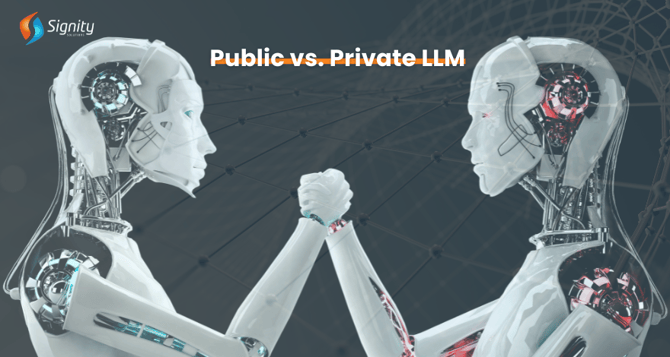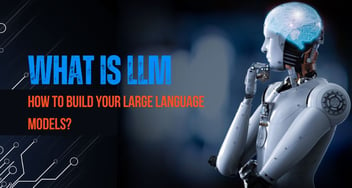Choosing The Right LLM: Public vs. Private LLM
Starting from ownership to integration- explore the differences between public and private LLMs. This blog will also help you learn about the challenges of implementing both, like security risks, costs, and limitations of resources, and help you decide which one suits your business best.

From healthcare and diagnostics to education, LLM services have made lives easier for people from every field. But did you know LLMs can be classified broadly into two types based on their accessibility—public and private LLMS?
LLMs are present everywhere today, and according to a study by Accenture, LLMs like GPT -4 can eliminate 40% of all working hours.
Before you build your own LLM, let us delve deep and try to find out the differences between the two.
Let’s get started!
Key Takeaways
- LLMs can be broadly divided into two categories- public and private LLMs.
- Public and private LLMs differ in many aspects, such as data privacy, utility, and scalability.
- People are eagerly looking forward to several future trends for both public and private LLMs, such as next-gen computing, integration with robotics, and more personalization.
- An efficient LLM development company will help the organization identify whether they should go for a public LLM or a private LLM.
Differences Between Public LLMs and Private LLMs
Understanding the fundamental differences between public and private LLMs is essential. This would definitely help firms determine the required use cases. While public LLMs like ChatGPT are accessible to all, private LLMs are tailored for specific organizations, prioritizing data security and control.
Let's explore these variances in detail.
1) Fundamental Difference
Let us explore what public LLMs specify. LLMs like ChatGPT, Gemini, and Llama2 are public LLMs. Some giants like OpenAI have developed them and are open to us, the general public.
Private LLMs, on the other hand, aren’t accessible to everyone. They are developed to serve a specific organization or firm and are not accessible to anyone outside the company or the organization. These are specially designed to minimize cybersecurity risks and data discrepancies.
2) Ownership
Are you a group of researchers who want to collaborate on a network or research open-source neural networks? Then, public LLMs are your go-to solution. There is no ownership barrier, and they are free to be used by anyone.
Now, picture this: Are you the CEO of a company that has just developed a low-code platform? Is the platform supposed to speed up the onboarding process of new employees into the firm? You obviously wouldn’t want to keep the platform open to your competitors. Your primary aim would be to gain a competitive edge over your peers. In instances like this, private LLMs come in handy.
3) Data Privacy
In public LLM development, third-party providers need to know the details of the public LLM used. This is mainly for training purposes or just to ensure overall data security. The LLMs are trained on huge datasets that may even contain confidential data.
In the case of private LLMs, the organization has full authority over the LLM’s ownership and details, and they are trained on much smaller datasets.
4) Usage
Since public LLMs are developed by tech institutions or independent research organizations, they are used for a wide variety of purposes, such as tasks related to NLP, machine translation, and even sentiment analysis. They are used across all domains today, like education, healthcare, defense service, legal consultation, and content generation.
In contrast, private LLMs are controlled and utilized exclusively by specific entities, often due to proprietary data considerations, security concerns, or the need for specialized applications. These models are deployed in environments where data privacy, security, and control are critical, such as financial institutions, healthcare organizations, and government agencies.
Determining the use cases for LLMs, both private and public, is difficult. However, if you contact a good LLM development company like Signity, we assure you that picking out the relevant use cases becomes easy.
5) Scalability
Latency issues are very common in public LLMs. For the uninitiated, in LLM development, latency time is the time required for an LLM to respond to a prompt or a query. It is the parameter that defines an LLM's speed or efficiency.
Public LLMs are typically based on cloud facilities, which allows them to access large chunks of data. You could start using public LLMs when your firm is in its nascent stage and then be amazed by its capacity to accommodate larger workloads with the progression of time.
Private LLMs, on the other hand, do not have cloud-native architecture options available, and scalability is low when the question of scalability arises. Before upscaling a private LLM, careful consideration, resource planning, and brainstorming are required.
6) Cost
Public LLMs differ from private LLMs in terms of cost. In the case of public LLMs, the cost is significantly less. Sometimes, public LLMs are available for free, too, just like the free version of ChatGPT.
However, the price of a private LLM is significantly higher as the data collection is much more systematic. The data is tailored according to the company’s business needs, the training procedures, and the resources required to maintain the data.
The expenses may go even higher in the case of private LLM development due to certain factors like usage volume and servers.
7) Integration
In terms of integration, private LLMs and public LLMs differ greatly when it comes to accessibility and control. Companies usually make public LLMs accessible to the general public using APIs or some other platform.
Integration methods in the case of public LLMs are always easier because they have to be made accessible to all and are usually developed to be used across several domains. There are fewer technical obstacles, and companies can easily use them without much customization.
Private LLMs are developed solely to adhere to a firm's specific business use cases. Hence, they have to be embedded very deeply in the company's neural networks or internal architecture. Often, custom APIs are needed to leverage the full power of a private LLM.
Challenges with Public LLMs and Private LLMs
While public and private LLMs offer distinct advantages, navigating their challenges is crucial for business success. Understanding these hurdles is essential for making informed decisions in the corporate landscape.
Below are the challenges associated with both. Let us have a look:
Public LLMs
Addressing Bias In Public LLMs
Public LLMs are very biased toward different aspects of demography, like culture, race, ethnicity, politics, etc. When it comes to areas that are socio-economically lacking, LLMS have been reported to generate particularly condescending outputs.
For example, when it comes to regions like Africa, chatGPT often gives biased answers based on beauty and morality.
Public LLM Hallucinations
Sometimes, public LLMs generate output that may seem accurate but is actually not. This phenomenon is called an LLM hallucination.
There are some techniques to mitigate LLM hallucinations, like advanced prompting, data augmentation, and fine-tuning.
Resource Limitations
This is a huge challenge to public LLMs, as without the required financial and technological resources, it is impossible to produce high-quality content and process vast quantities of data. Due to this factor, handling complex tasks might become a hassle.
Apart from this, ease of scalability and the ability to meet increasing customer demands will also be a hassle. To avoid this, resource optimization and using effective computational tactics to manage public LLMs are good solutions.
Challenges with Private LLMs
Limited Customization
Private LLMs, unlike public LLMs, are not based on open-source neural networks. In open source, customization and modification is seamless. In the case of private LLMs, there are internal security concerns, so it’s very difficult to implement any customization in the system.
Also, customization limitations make it very difficult for LLM developers to eliminate ethnic, racial, political, or gender-elated biases within the system. To get rid of hallucinations, too, private LLMs need to be exposed to a vast number of cultural contexts, which becomes very difficult. This affects the accuracy of the output generated.
Costs
Reducing costs is always a major mandate for any firm. A private LLM is pretty expensive—the development, training, deployment, and maintenance.
There is a lot of data used for training large language models, and this takes up a lot of memory space and even processing. Moreover, maintenance and tracking of the private LLM are tasks that a regular workforce can't do. A firm needs trained employees for the same, and this, in turn, significantly expands the financial budget.
Security Risks
From the time a private LLM is implemented or developed to the usage phase when an organization's employees actively use it, it faces multidirectional threats from cybersecurity miscreants.
LLMs have been accused of harrowing certain biases toward certain communities and ethnicities. In addition, cybersecurity scammers will try to manipulate the input being given to private LLMs, which will generate unwanted outputs and spread misinformation.
Data Ownership
Obtaining proprietary rights from a company is very important when it comes to private LLM development. However, it is also time-consuming. It is also very important that the data collected is compliant with the GDPR Act and other regulatory guidelines.
Private LLMs must adhere to regulatory requirements regarding usage, storage, deployment, and maintenance. Ownership policies regarding LLM development services must be transparent from the very beginning to avoid any discrepancies.
Future Trends and Considerations
According to BIS Research, the LLM market is predicted to grow at a CAGR of 29.61% till 2034.
This shows that public LLMs and private LLMs are game-changers already. But there is room for more innovative advancements. Let us take a look:
More Personalization
Both public and private LLMs are deemed to be more personalized as the days go by. While public LLMs will not be more customizable, if you are using them, you will be able to access additional built-in tools for customization purposes.
This will benefit organizations and firms who want tailored solutions for their businesses. Private LLMs will be used by firms all the more for data collection and data analysis, allowing forms to make more informed decisions, Moreover, the data will be more secure and up-to-date with the latest cybersecurity practices.
Deep Integration with Robotics
We all know how robotics and automation are changing the technological landscape today. From the healthcare domain to legal services, automated robots have been speeding up processes and increasing the productivity of organizations like crazy.
In the near future, LLM services will power automated robots on a large scale. In manufacturing domains, private LLMs will collaborate with automated systems to elevate the efficiency of supply chain processes. Personalized robotic solutions like wearable technologies measuring your calorie intake and AI home assistants will become a common phenomenon.
Next-gen Computing
When it comes to large language models, the focus is always on “what can be better?." In the future, next-gen computing is going to become the most sought-after trend when it comes to both public and private LLMs.
It’s true that LLM services already handle complex situations and solve complex problems. However, with stellar technology like neuromorphic computing in the near future, there will be no end to the possibilities for LLM development. Apart from this, there will be breakthroughs in NLP technology with the help of advanced GPUs and customized software.
Ethical AI governance
Public LLMs will consider societal situations and norms before generating output and work on autonomous networks that provide instant feedback on the outputs. The answers generated by the LLM model will be audited in real-time.
In the case of private LLMs, firms will take social responsibility more seriously and deploy AI modules within the LLM networks. They will constantly monitor the LLM, looking for biases and prejudiced outputs.
How Can Signity Assist You In Your LLM Development Journey?
One sure thing is that even though public and private LLMs are similar in a lot of ways, they are also different. Navigating between the differences and deciding on what is needed for your business is not an easy task
But there are LLM development services to help you with that exactly. If you go for a trusted firm like Signity, they will not only help you with the use cases but also suggest ways in which you could overcome the challenges with respect to both public and private LLMS.
 Our firm brings a vast collection of technical expertise in technologies such as NLP, machine learning, few-shot learning, and sentiment analysis.
Our firm brings a vast collection of technical expertise in technologies such as NLP, machine learning, few-shot learning, and sentiment analysis.















